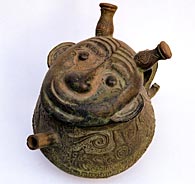 China's tea appreciation culture has a long history and more diversified than what a lot of people have imagined, but an exhibition entitled "A Story About Teapots" currently held in Hong Kong tells the story.
China's tea appreciation culture has a long history and more diversified than what a lot of people have imagined, but an exhibition entitled "A Story About Teapots" currently held in Hong Kong tells the story.
The exhibition, held by the Hong Kong SAR Leisure and Cultural Services Department, allows visitors not only to view a fine selection of teapots and tea ware, but also to appreciate the diversity of the art across several dynasties in Chinese history.
The theme of this exhibition focuses on how teapots evolved, as the art of drinking tea changed across several dynasties, whereas in the past the themes focused on the poetry and the glazed colors on teapots, according to Grace Kwok, an assistant curator of the Flaffstaff House Museum of Tea Ware.
"In the Ming (1368-1644) Dynasty, the abandoning of production of tea cakes and the use of refined tea leaves have caused the ensuing teapots to possess a handle and a beak," she said, citing an example.
A bigger-than-usual ancient teapot is also displayed to demonstrate a tea serving in larger gathering settings.
"But soon, people realized that the unused portion of the infusion with tea leaves leaving in the pot for too long will cause it to become bitter, and as a result, smaller tea pots were designed," she said.
The exhibition also explains how tea was made in China in the earliest time, such as the Han (BC206-220AD) and Tang (618-970) dynasties.
Before the Tang Dynasty, tea drinking was very popular among the people in the Southern part of China. During this period, tea was popularly made from boiling leek, ginger, mint, date, dogwood and orange peel together in a pot, much like how tea was made in the Han Dynasty.
Whipped tea was then introduced in the Song (960-1279) Dynasty. Tea leaves were ground into powder to be dissolved in water whipped with a bamboo whisk to make a frothy brew for consumption.
According to Kwok, the Ming Dynasty marked the method of tea appreciation which influenced modern tea drinking most -- refined tea leaves were steeped in cup of hot water whose temperature has to be carefully controlled.
Common flowers used for scenting tea include Water Lilies, Orchid, Osmanthus and orange flowers, and contemporary examples of scented tea are Jasmine tea, Rose tea and Osmanthus broken lack tea, she said.
The exhibition also features over 100 items of teapots and tea wares made between the Ming Dynasty and the 20th century.
Exhibits also include Yixing potteries, underglaze-blue, monochrome or polychrome teapots, kettles and ewers.
Alan Schumann, a visitor, said he was initially interested in the health-promoting effect of tea drinking.
"I love fried food, but it is very high in cholesterol, so I've read about the Polyphenols in green tea can consume the cholesterol and can prevent cancer as well. So I came to check out on any information about tea production," he said
Grace Kwok said that by the closing of the exhibition on March 10, about 90,000 people are expected to have visited the exhibition.
(Eastday.com January 19, 2002)
